Solar eclipse
By Oli Usher, on 20 March 2015
 Close
Close
News, anecdotes and pictures from across science and engineering at UCL

By Oli Usher, on 20 March 2015
By Oli Usher, on 16 March 2015
It’s a setup worthy of Heath Robinson. In a faraway galaxy, a high energy cosmic ray interacts with a photon, producing a series of particle decays eventually releasing a neutrino. The neutrino then crosses billions of light years of space, punching through dust, gas and nebulae without effect. Eventually it reaches Earth, plunges through our atmosphere and finally meets something it cannot pass through: our planet.
When it reaches Earth, scientists hope to detect it. But the complications are only beginning.
High energy neutrino impacts are rare. A cubic kilometre of matter should typically see one roughly once every century. When it does, it triggers a brief and not particularly bright flash of microwave radiation – at the same wavelength and intensity as the flashes from piezoelectric cigarette lighters.
Detect these rare flashes, and you can detect the impact of neutrinos.
Scientists are patient people, and science is no stranger to large and expensive experiments. But building a detector of a cubic kilometre in size, far away from any sources of accidental interference – then waiting potentially a century or more to see a single result – is not reasonable.
Scientists need, somehow, to use the Earth itself as a giant detector, to increase the odds of seeing one.
Searching for somewhere remote enough that the faint signal doesn’t get drowned out, big enough to act as a natural detector, and dry enough not to absorb the microwaves, has taken UCL’s Ryan Nichol to Antarctica three times in the last decade.
There, ANITA (Antarctic Impulsive Transient Antenna), the instrument he works on, circles the South Pole, suspended from a balloon, monitoring a million cubic kilometres of ice for the telltale flash of microwaves that would signal a neutrino detection.
***
Scientists are targeting neutrinos because of what they tell us about cosmic rays.
Cosmic rays are fast-moving particles – usually protons and ions – that bombard the Earth’s upper atmosphere. Some of these move at exceptionally high speeds, up to 99.99999999999999999999% of the speed of light, giving them vast amounts of kinetic energy. A single one of these particles can have the same energy as a cricket ball travelling at 55 miles per hour. But frustratingly, their origins are shrouded in mystery. They must come from some kind of high-energy phenomenon – such as supernovae, black holes or the centres of galaxies – but we can’t figure out what.
Ultra-high energy cosmic rays can travel a long way, but they can’t travel infinitely far. They can interact with photons (light particles), which are everywhere in the Universe, even the vacuum between galaxies. This means that cosmic rays eventually – after about a hundred million light years – come to a halt.
As a result, all the cosmic rays detected in Earth’s upper atmosphere come from a region that includes our galaxy and a few neighbouring ones, but not from the hundreds of billions of galaxies that lie further away. This is by no means a small volume of space, and yet astronomers have come up empty handed when trying to pinpoint the origins of high energy cosmic rays within our cosmic neighbourhood. They need a way of broadening the search.
By looking for high energy neutrinos instead – which are launched like billiard balls by cosmic rays when they interact with photons, but which, unlike them, can cross the void of space without interacting – particle physicists like Nichol hope to extend the search radius from a few tens of millions of light years to several billion.
This should give them a large enough sample to begin to plot where the highest energy cosmic rays are coming from, and see if they can match this up with known objects in the sky that could be causing them.
But first, they need to develop a reliable way of spotting the neutrinos, which is where ANITA comes in.
And for ANITA to do its job, Nichol needs to get to Antarctica. Even in this age of easy international travel, this is not simple. Without any permanent inhabitants, Antarctica has no towns, isn’t visited by scheduled airlines, and even in the brief Antarctic Summer, is still cold and battered by extreme weather.
***
Nichol’s base of operations in Antarctica is McMurdo Station, the largest scientific research station on the continent. It looks like a cross between a mining town and a scruffy university campus – with halls of residence, cafeterias serving mediocre food, and social life centred on a few slightly disreputable bars.
Located on the coast, and served by several runways, McMurdo is one of the gateways to the constellation of smaller research stations dotted around Antarctica. Its summer population tops 1000 – not just researchers, but engineers, cooks, cleaners, drivers – but most of the scientists are just passing through, waiting for connecting flights to more remote stations where they will carry out their research.
For one group of scientists, though McMurdo is perfectly placed: those carrying out research using balloons. High in the sky above the base, a constant, predictable wind blows. Release a balloon into this, and it will gently float in a giant circle around Antarctica, before returning to where it started about two weeks later.
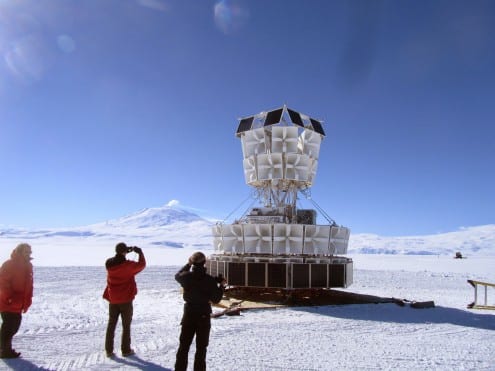
ANITA prior to being attached to the balloon. In the background, Mount Erberus, the second-highest volcano in Antarctica. Photo: Ryan Nichol
For the first couple of days after ANITA is released, McMurdo base is still in range. ANITA floats high in the atmosphere, around three times the altitude of commercial airliners, and so the base, with all the radio interference that comes from it, remains above the horizon for a long time. But once out of range, the only interference is the occasional chirp from communications satellites high above. ANITA silently watches the ice, recording vast amounts of data, and storing it for analysis later on.
The first two flights have not conclusively detected any high energy neutrinos yet. There has been one tentative detection, but the scientists would want to see several before being confident that they hadn’t just seen a false positive.

The flight of ANITA 3 in December 2014/January 2015. The path in red shows the balloon veering off course and ending its journey near Davis base.
This may all change soon. The third flight’s results are on their way home now – and taking a suitably convoluted route back. The December 2014 observations had to be cut short after the balloon blew off course, and the ANITA experiment was jettisoned onto the ice.

ANITA after crash-landing on the ice. Photo: © Josh F/Australian Antarctic Division
Rescued by helicopter and returned to an Australian base, ANITA is now waiting to board the icebreaker Aurora Australis for the journey to Tasmania. The research team hope to get it back next month.
The most recent ANITA mission featured more sensitive instrumentation than the previous two. Given this, the scientists are hopeful – though not certain – that they will get some more tangible results than previous years. They estimate that they should detect somewhere between 0 and 5 high energy neutrino events in this year’s data. So, barring bad luck, the planning, the cold and the years of hard work may just pay off.
***
So if you’re part of the ANITA team, that’s how you detect the highest energy cosmic ray in the Universe. All you need is for it to interact with a photon, emitting a neutrino that flies across billions of years of space before colliding with a water molecule, emitting a flash of microwaves. And for the flash of microwaves to be detected by a sensor suspended from a balloon floating 35km over the most remote and inhospitable region of the world, for the detection to be recorded onto a hard disk, for the hard disk to be dropped onto the ice, then rescued by helicopter, shipped by icebreaker and flown back to the lab, to be decoded by a physicist.
It’s simple, really.
By Oli Usher, on 12 March 2015
UCL has played a key role in the development of the Dark Energy Survey’s instrumentation, including building a series of lenses that form a crucial component of the Dark Energy Camera. UCL’s Ofer Lahav also serves as co-chair of the Dark Energy Survey science committee.
The Dark Energy Survey team published a new result this week that shows the power of the instrument.
The Milky Way is surrounded by a few dozen dwarf galaxies. Some of these are easy to spot, like the Large Magellanic Cloud, which is visible even to the naked eye as a pale blob in the Southern Hemisphere’s sky, clearly separate from the Milky Way.
Others are much harder to spot, as it is virtually impossible to distinguish their stars from the ones in the foreground, which are part of the Milky Way. Now, the Dark Energy Survey has discovered what appears to be several more. This image shows the challenge in identifying them:
The image shows one of the candidate galaxies, known as DES J0335.6-5403. It sits around 100,000 light years from Earth, and has very few stars, only around 300 could be detected, compared to an estimated 200 billion stars in the Milky Way.
The team were, however, able to analyse the image and mask all the stars that belong to our Milky Way. And when you do that, the dwarf galaxy suddenly jumps out at us:
Although UCL’s involvement in this study was only minor, it shows the power of the instrument and its contribution to the science over the past decade.
By Oli Usher, on 19 February 2015
Guest post by Anita Heward
The potential for exoplanet research to inspire students and widen participation at university from under-represented groups will be highlighted today at 11 Downing Street.
Dr Clara Sousa Silva, who completed her PhD at UCL last year, has been invited to give a four-minute presentation during an event hosted by the Chancellor for Your Life and Researchers in Schools (RIS). Clara is currently participating in the RIS teacher training and professional development programme.
The programme builds links between universities and schools by training researchers that have completed PhDs to become classroom teachers, while supporting them for 20% of their time to pursue academic interests. Clara is training as a physics teacher at Isleworth and Syon School for Boys and, through the RIS programme, is continuing aspects of her research into atmospheric characterisation of cool stars and exoplanets.
Clara also heads up the education programme for Twinkle, a UK space mission that will characterise exoplanet atmospheres using an instrument led by UCL.
EduTwinkle will draw on Clara’s experiences with RIS and the Brilliant Club to foster a productive relationship between space exploration and British schools, increase girls’ uptake of STEM subjects at A-level and higher education and to widen participation at universities from under-represented communities.
By Oli Usher, on 16 February 2015
While astronomers expend a lot of effort trying to see things better – building ever more powerful telescopes that can detect even the faintest, most distant objects – they are occasionally faced with the opposite problem: how to unsee things that they don’t want to see.
A group of scientists led by UCL’s Emma Chapman is working on methods to solve this problem for a new radiotelescope that is currently under development. In so doing, they could help give us our first pictures of a crucial early phase in cosmic history.
How to avoid seeing things you don’t want to see is a particular problem for cosmologists – the scientists who study the most distant parts of the Universe. Many of the objects and phenomena that interest them are faint, and lie hidden beyond billions of light years of gas, dust and galaxies. To make matters even more difficult, telescopes are flawed too – the data from them is not perfectly clean, which is manageable when you’re looking at relatively bright and clear objects – but a serious problem when you’re looking at the faint signature of something very far away.
Observing these phenomena is much like looking at a distant mountain range through a combination of a filthy window, a chain-link fence, some rain, clouds… and a scratched pair of glasses. In other words, you’re unlikely to see very much at all, unless you can somehow find a way to filter out all the things in the foreground.
***
The Square Kilometre Array (SKA) is a new radiotelescope, soon to begin construction in South Africa and Australia. The SKA will use hundreds of thousands of interconnected radio telescopes spread across Africa and Australia to monitor the sky in unprecedented detail and survey it thousands of times faster than any current system.
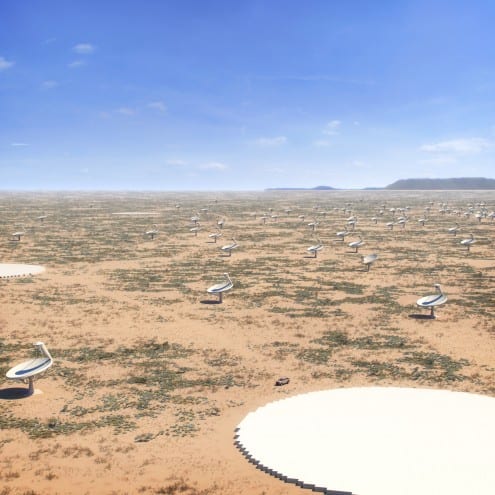
Artist’s impression of the South African site of the Square Kilometer Array. Credit: SKA Organisation (CC BY)
One of its objectives is to make the first direct observations of a brief phase of a few hundred million years in cosmic history known as the ‘era of reionisation’. This technical term conceals something quite dramatic: a profound and relatively sudden transformation of the whole Universe, which led to the space between galaxies being fully transparent to light as it is today.
By ucapjo0, on 9 February 2015
Jonathan Oppenheim has co-authored a new paper on quantum thermodynamics, which can be read here.
You’re probably familiar with the second law of thermodynamics in one of its many forms:
Anything that can possibly go wrong, does.
— Murphy’s law
“Happy families are all alike; every unhappy family is unhappy in its own way.”
— Leo Tolstoy in Anna Karenina, almost 20 years before Boltzmann’s Kinetic Theory of Gases
Shit happens
— ancient proverb
Because every day we feel the consequences of the second law. Even Homer Simpson has been known to admonish his children: “In this house, we obey the laws of thermodamynics!” Not that Bart or Lisa would have much choice. The second law of thermodynamics governs much of the world around us – it tells us that a hot cup of tea in a cold room will not spontaneously heat up; it tells us that unless we are vigilant, our homes will become untidy rather than tidy; it tells us how efficient the best engines can be and even helps us distinguish the direction of time – we see vases shatter, but unless we watch movies backwards, never see the time-reverse – a shattered vase reforming with just a nudge.
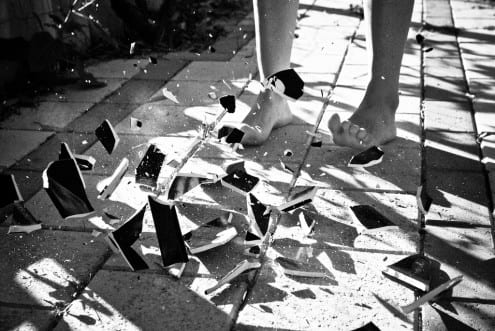
Vases do not spontaneously unbreak themselves. Photo: Drew Bandy (CC BY NC SA)
The second law tells us that order tends towards disorder, something we are all very familiar with — trying to achieve a very specific state of affairs can be very difficult, because there are many different ways things can go wrong. Murphy’s Law (anything that can go wrong, will go wrong), is a reasonable statement of the second law of thermodynamics. As is its less precise version “Shit happens”.
More concretely, the second law tells us that for isolated systems, the entropy, a measure of disorder, can only increase. I like to think of the second law as constraining what can happen to a system — left on its own, things don’t get more ordered.
But the laws of thermodynamics only apply to large classical objects, when many particles are involved. What do the laws of thermodynamics look like for microscopic systems composed of just a few atoms? That laws of thermodynamics might exist at the level of individual atoms was once thought to be an oxymoron, since the laws were derived on the assumption that systems are composed of many atoms.
Are there even laws of thermodynamics at such a small scale?
The question is becoming increasingly important, as we probe the laws of physics at smaller and smaller scales.
Statistical laws apply when we consider large numbers. For example, imagine we toss a coin thousands of times. In this case, we expect to see roughly equal numbers of heads as tails, while the chance that we find all the coins landing heads is vanishingly small. If we imagine tossing a larger and larger number of coins, the chance of having an anomalous coin tossing such as all tails goes to zero and our confidence that we’ll have roughly half heads, half tails, increases until we are virtually certain of it.
However, this is not true when tossing the coin just a few times. There’s a reasonable chance we will find all the coins landing tails. So, can we say anything reasonable in such a case? Similar phenomena occur when considering systems made out of very few particles, instead of very many particles. Can we make reasonable thermodynamical predictions, about systems which are only made up of a few particles.
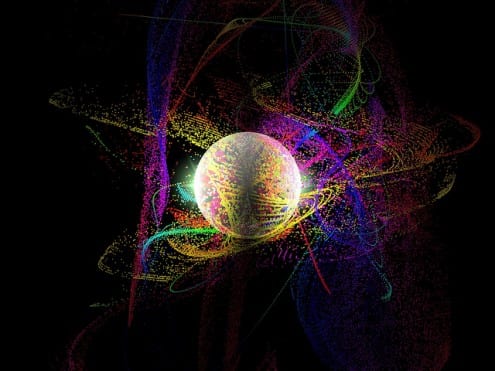
Can we even talk about the laws of thermodynamics when we’re only looking at a handful of particles? Picture credit: Stef Simmons (CC BY)
Surprisingly, the answer is yes, and the mathematical tools from a field known as quantum information theory help us to understand the case when we don’t have a large number of particles. What we find, is that not only does the second law of thermodynamics hold for quantum systems, and those at the nano-scale, but there are even additional second laws of thermodynamics. In fact, there is an entire family of second laws. So, while Murphy’s law is still true at the quantum scale — things will still go wrong; the ways in which things go wrong is further constrained by additional second laws. Because remember, the second law is a constraint, telling us that a system can’t get more ordered. These additional second laws, can be thought of as saying that there are many different kinds of disorder at small scales, and they all tend to increase as time goes on. What we find is a family of other measures of disorder, all different to the standard entropy, and they must all increase.
This means that fundamentally, there are many second laws, all of which tell us that things become more disordered, but each one constrains the way in which things become more disordered. Why then does there only appear to be one second law for large classical systems? That’s because all the second laws, although different at microscope scales, become similar at larger scales. At the scale of the ordinary objects we are used to, all the quantum second laws are equal to the one we know and love.
What’s more, it can sometimes happen that the traditional second law can appear to get violated – quantum system can spontaneously become more ordered, while interacting with another system which barely seems to change. That means some rooms in the quantum house may spontaneously become much tidier, while others only become imperceptibly messier.
What do these additional second laws look like? Well, first let’s get a bit more technically dirty. If you already know your thermodynamics fairly well, this is a good point to join us. For those who’ve had enough, here is a picture of Watt’s steam engine. It’s big enough that none of these additional second laws matter.
By Oli Usher, on 9 February 2015

Twinkle. Credit: SSTL/Twinkle/DSS
A new satellite for observing extrasolar planets could be in orbit within four years, under plans drawn up by UCL and Surrey Satellite Technology Limited (SSTL). The Twinkle satellite, pictured above, will observe the light of distant stars with planets orbiting them.
As a planet passes between the star and Twinkle’s telescope, a small amount of the light passes through its atmosphere, imprinting on it the chemical signature of its atmosphere. This technique has been used by Hubble to analyse the atmospheres of a handful of exoplanets, but the Twinkle team hopes to probe at least 100 during the spacecraft’s mission.
UCL leads a consortium of UK institutes who will construct Twinkle’s scientific instrumentation, a highly precise infrared spectrometer which can tease out the faint signature of the planetary atmospheres from the starlight.
By Oli Usher, on 2 February 2015

Last week, asteroid 2004 BL86 passed near Earth. The ball of rock, a little over 300 metres across, passed 3.1 lunar distances from Earth.
This is far enough not to be of any serious concern – but it is closer than any other known asteroid will come to us until 2027. If an asteroid like 2004 BL86 were to hit Earth, we could expect widespread destruction – the famous Barringer Crater in Arizona was gouged out by an object just 50 metres across.
During its close approach, UCL’s observatory spotted the asteroid and snapped the picture above: a series of 30 second exposures separated by 9 second gaps. The asteroid can be seen moving rapidly against the background stars as the telescope was programmed to track the movement of the stars.
Reprogramming the telescope to hold the asteroid in its sights creates the image below – with the stars appearing as streaks instead.

This video, featuring a series of observations of the asteroid made at the observatory over the night of 26-27 January, shows both types of observation, including a long shot tracking the asteroid across the sky.
Images by Steve Fossey, Theo Schlichter and Ian Howarth.
By ucapowe, on 7 January 2015
Amidst the indescribable stress that is writing up my PhD, there is a massive silver lining. I’m currently writing this from 2,800m (that’s about 9,200 feet), half way up the Mauna Kea volcano in Hawaii. I say volcano, it’s not actually erupted for several thousand years and (the reason that I’m here) it has billions of pounds worth of massive telescopes on top of it.

The peak of Mauna Kea, with Subaru, Keck 1, Keck 2 and NASA IRTF telescopes. Photo: Alan L (CC BY)
During the second year of my PhD, my supervisors and I, whilst looking at some data everyone had assumed was assumed was empty, discovered the first molecule containing a noble gas in it in space. Those of you who know anything about Chemistry will know this is really weird. Noble gasses are so named because they’re noble: they don’t mix with the other elements.
However, in the remnants of a star that exploded around 1000 years ago, the conditions for it to actually do so happened. This is a massive deal and needs following up quickly – which as well as taking over a substantial chunk of my time over the past year has now brought me to Hawaii.
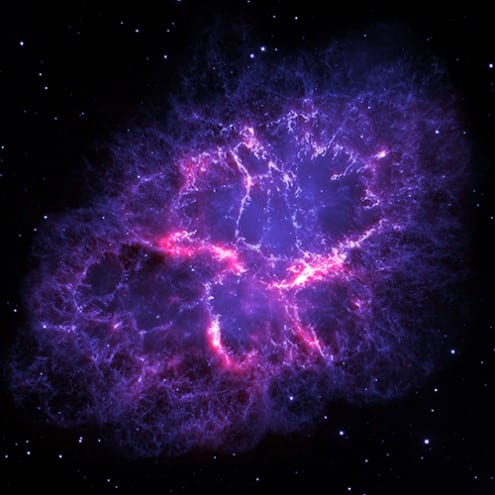
The Crab Nebula – where UCL researchers discovered argon hydride molecules. Photo credit: NASA/ESA/Hester/Loll/Barlow
Last night was my first trip up to the summit, where I spend several hours at NASA’s Infrared Telescope Facility. It’s an odd experience being that high up. Everything needs to be a little bit slower. There are perpetual reminders that you are somewhere not normal. From the warning signs to the bottles of oxygen placed liberally around the control room.
People don’t function so well that high up.
Our trip was mostly to acclimatise to the 4,200m altitude and get used to the instruments we will be using. This is a good thing, because while Mauna Kea has 350 clear nights a year, last night was not one of them.
Last night there was a storm. The drive up to the summit was a pretty hairy experience with squalls of wind and rain. Thankfully it wasn’t me doing the driving.
The only work that needed doing last night was calibration set up, for which we didn’t need to be able to actually see stars. Just as well, as there’s no way that we could have.
This weather system should have passed by tomorrow so we’ll be free to do science.

NASA Infrared Telescope Facility. Photo: Afshin Darian (CC BY)
* * *
Tonight’s drive up was much clearer. As well as stars we could see the top of a thunder storm out over the pacific and the orange glow from a neighbouring volcano (a nice reminder that although it hasn’t erupted for several thousand years, Mauna Kea is not actually extinct).
Clearer… until we got to the summit.
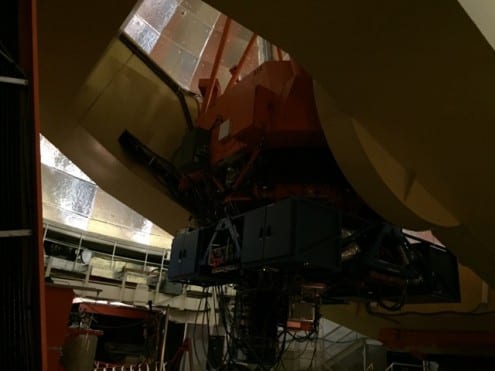
Inside the NASA Infrared Telescope Facility. Photo: Patrick Owen
Having prepared and calibrated everything and chosen our first standard star to use as a check for everything, the Telescope Operator said “no”.
Apparently it’s 100% humidity outside and it is lovely and misty.
We had a slight tease at about midnight: we got as far as opening the telescope dome and finding our standard star. Alas, just as we started taking actual measurements the humidity shot back up and we had to close the dome.
There’s a massive difference when we get up to the summit tonight! Stars! I can see stars, not particularly brightly, which is mostly to do with the lack of oxygen at this altitude meaning my eyes aren’t working as well as they should, but stars!

NASA Infrared Telescope Facility at night. Photo: NASA
If I can see stars, the telescope can see stars. After some changing of instruments and refilling of coolants (no mean feat at that altitude) we were finally ready to get started. We found and observed out standard star without much of an issue.
Then we started looking for the little “knots” of gas we are observing in the Crab Nebula. This took us a while longer than planned, but we got there and all lined up on the instrument so we could get the data we need. Nothing. Tried again. Nothing. By this time it was also about 3am, the combination of the time and the lack of oxygen made this all rather difficult to cope with.

The Crab Nebula is full of knots and filaments of gas. Photo: NASA/ESA/Hester/Loll/Barlow
We set the telescope to run for a two hour run to see if we could get anything at all. Other than some cosmic rays (really not what we’re looking for at all) we got… nothing. Frustration and worry about our calculations and whether what we were doing was right ensued. I paced. Lots. As the sun came up I went outside to get some fresh air (and see the telescopes, I’d only been up here in the dark until now), before heading down to the base camp for some fried food and sleep.
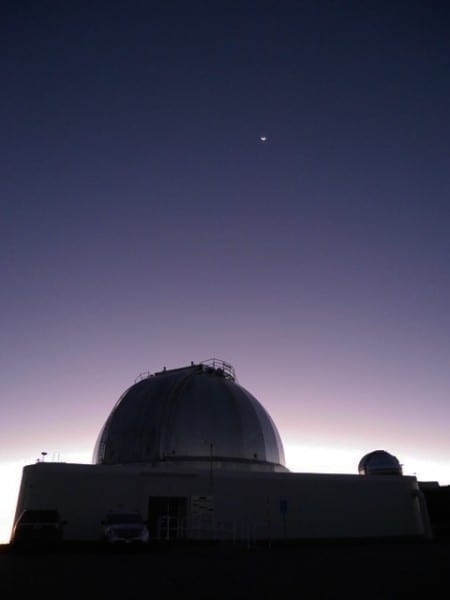
The telescope at dawn, with crescent moon. Photo: Patrick Owen
I woke up this “morning” to an email telling me that there had been something wrong with the instrument. Good news as it means we’re probably going to get some good data this evening. Bad news because it was a really simple fix that had we known about it would have allowed us to get some good data last night too.
Ah well, onwards and upwards. After another slog to get set up and find a new brighter standard star and things, we got observing.
Final night lucky, at about half past three, we finally realised we’d found what we were looking for! Massive amounts of relief all round, we still had to finish the run and get as much data as we could before the sun came up, but we got some.
It’ll take several weeks of processing the data followed by several more weeks of analysis before we know exactly what we have.
That can wait until after I’ve finished writing my thesis.

Sunset from base camp. Photo: Patrick Owen
Patrick Owen is a PhD student in UCL Physics & Astronomy, and has recently returned from observing in Hawaii
By Oli Usher, on 15 December 2014
December’s Sky at Night was practically a UCL full house.
As well as Maggie Aderin-Pocock (UCL Physics & Astronomy) presenting, the programme featured UCL astronomers Serena Viti and Steve Fossey, UCL chemists Andrea Sella and Stephen Price, and was filmed at UCL’s observatory.
Well worth a watch – viewers in the UK can watch the programme again on BBC iPlayer until 14 January 2015 by clicking above.
The show will also be repeated on BBC Four at the following times: 7.30pm on 18 December, and 2am on 19 December.